1) Which of the following statements about species, as defined by the
biological species
concept, is (are) correct?
I. Biological
species are defined by reproductive isolation.
II. Biological
species are the model used for grouping extinct forms of
life.
III. The biological species is the largest unit of
population in which successful reproduction
is possible.
A)
I only
B) II only
C) I and III
D) II and III
E) I,
II, and III
C
The system of classification developed by Linnaeus is based primarily on differences in
a. similarity in embryonic development
b. ability to interbreed freely
c. similarity in structure
d. similarity in behavior patterns
e. distribution into a definite geographical area
c
There is still some controversy among biologists about whether
Neanderthals should be
placed within the same species as modern
humans, or into a separate species of their own.
Most DNA
sequence data analyzed so far indicate that there was probably little
or no gene
flow between Neanderthals and Homo sapiens. Which
species concept is most applicable in
this example?
A)
phylogenetic
B) ecological
C) morphological
D) biological
D
If two continental land masses converge and are united, then the collision should cause
a. a decrease in climatic extremes in the interior of the new super continent
b. the extinction of any species adapted to intertidal and coastal habitats
c. an overall decrease in the surface area located in the continental interior
d. a net loss of intertidal zone and coastal habitat
e. the maintenance of the previously existing ocean currents and wind patterns
D
WHICH OF THE FOLLOWING CONTRIBUTES LEAST TO SPECIATION?
A: SEXUAL REPRODUCTION
B: ASEXUAL REPRODUCTION
C:
ISOLATION
D: VARIATION
B
The legless condition that is observed in several groups of extant reptiles is the result of
A) their common ancestor having been legless.
B) a shared adaptation to an arboreal (living in trees) lifestyle.
C) several instances of the legless condition arising independently of each other.
D) individual lizards adapting to a fossorial (living in burrows) lifestyle during their lifetimes.
C
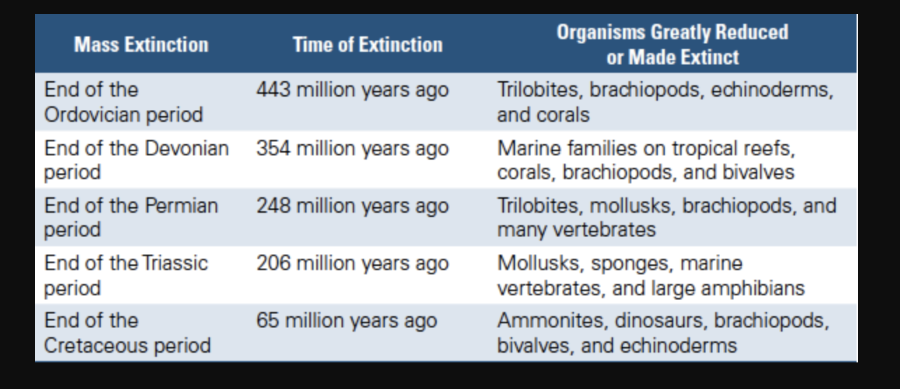
A group of students summarized information on five great extinction events.
The students are sampling a site in search of fossils from the Devonian period. Based on the chart, which of the following would be the most reasonable plan for the students to follow?
(A) Searching horizontal rock layers in any class of rock and trying to find those that contain the greatest number of fossils
(B) Collecting fossils from rock layers deposited prior to the Permian period that contain some early vertebrate bones
(C) Looking in sedimentary layers next to bodies of water in order to find marine fossils of bivalves and trilobites
(D) Using relative dating techniques to determine the geological ages of the fossils found so they can calculate the rate of speciation of early organisms
B
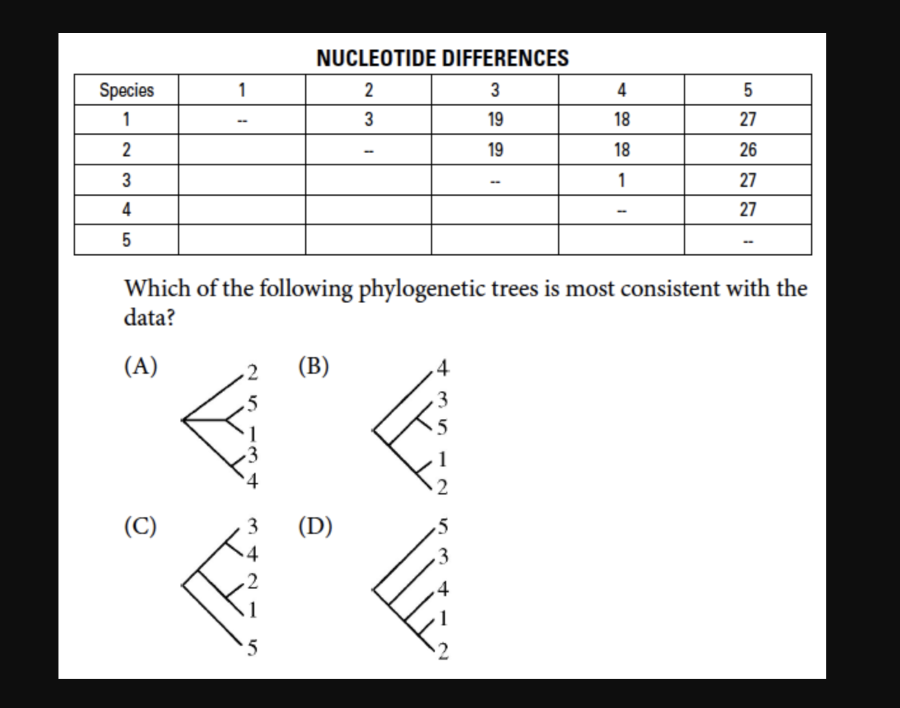
Five new species of bacteria were discovered in Antarctic ice core samples. The nucleotide (base) sequences of rRNA subunits were determined for the new species. The table below shows the number of nucleotide differences between the species.
Which of the following phylogenetic trees is most consistent with the data?
C
The asteroid hypothesis is associated most prominently with which of the following events in the
history of life?
A) origin of life B) origin of humans C) origin of eukaryotes
D) Permian extinctions E) Cretaceous extinctions
E
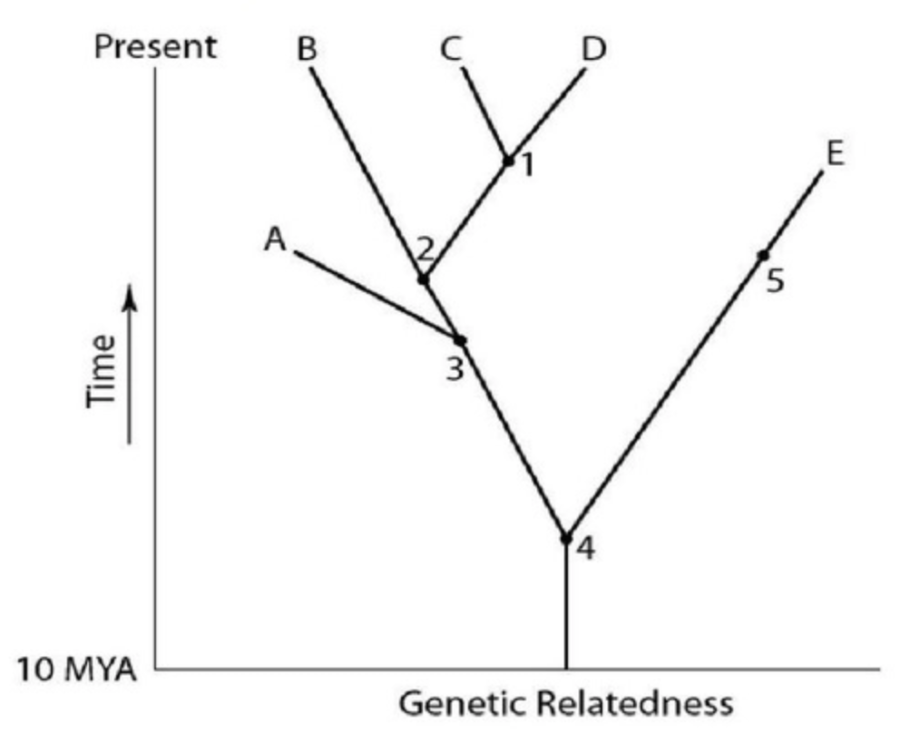
A common ancestor for both species C and E could be at position
number __________.
(a) 1
(b) 2
(c) 3
(d)
4
(e) 5
4

The two extant species that are most closely related to each other
are __________.
(a) A and B.
(b) B and C.
(c) C and
D.
(d) D and E.
(e) E and A.
C

Which species are extinct?
(a) A and E
(b) A and B
(c)
C and D
(d) D and E
(e) cannot be determined from the
information provided
a

If this evolutionary tree is an accurate depiction of relatedness,
then which of the following should be
correct?
1. The
entire tree is based on maximum parsimony.
2. If all species
depicted here make up a taxon, this taxon is monophyletic.
3. The
last common ancestor of species B and C occurred more recently than
the last
common ancestor of species D and E.
4. Species A
is the direct ancestor of both species B and species C.
5. The
species present at position 3 is ancestral to C, D, and E.
(a) 2
and 5
(b) 1 and 3
(c) 3 and 4
(d) 2, 3, and 4
(e)
1, 2, and 3
e

Which extinct species should be the best candidate to serve as the outgroup for the clade whose common ancestor occurs at position
A
Two species of orchids with different floral anatomy have which type of reproductive isolation
a. behaviorial
b. gamatic
c. habitat
d. mechanical
e. temporal
D
two species of trout that bread in different seasons have which type of reproductive isolation
a. behaviorial
b. gamatic
c. habitat
d. mechanical
e. temporal
E
Two species meadowlarks with different mating songs have which type of reproductive isolation
a. behaviorial
b. gamatic
c. habitat
d. mechanical
e. temporal
A
Two species of garter snakes live in the same region, but one lives in water and the other lives on land have which type of reproductive isolation
a. behaviorial
b. gamatic
c. habitat
d. mechanical
e. temporal
C
mating fruit flies that recognize the appearance odor and sounds of members of their own species but not others have which type of reproductive isolation
a. behaviorial
b. gamatic
c. habitat
d. mechanical
e. temporal
A
The four-chambered hearts of birds and the four-chambered hearts of
mammals evolved
independently of each other. If one were unaware
of this independence, then one might logically conclude
that
__________.
(a) the birds were the first to evolve a 4-chambered
heart
(b) birds and mammals are more distantly related than is
actually the case
(c) early mammals possessed feathers
(d)
the common ancestor of birds and mammals had a four-chambered
heart
(e) birds and mammals should be placed in the same family
d
Cladograms (a type of phylogenetic tree) constructed from evidence
from molecular systematics are
based on similarities in
__________.
(a) morphology
(b) the pattern of embryological
development
(c) biochemical pathways
(d) habitat and
lifestyle choices
(e) mutations to homologous genes
e
Shared derived characters are most likely to be found in taxa that
are __________.
(a) paraphyletic
(b) polyphyletic
(c) monophyletic
C
A taxon, all of whose members have the same common ancestor, is
__________.
(a) paraphyletic
(b) polyphyletic
(c) monophyletic
C
The term that is most appropriately associated with clade is
__________.
(a) paraphyletic
(b) polyphyletic
(c) monophyletic
C
If birds are excluded from the class Reptilia, the term that
consequently describes the class Reptilia is
__________.
(a)
paraphyletic
(b) polyphyletic
(c) monophyletic
a
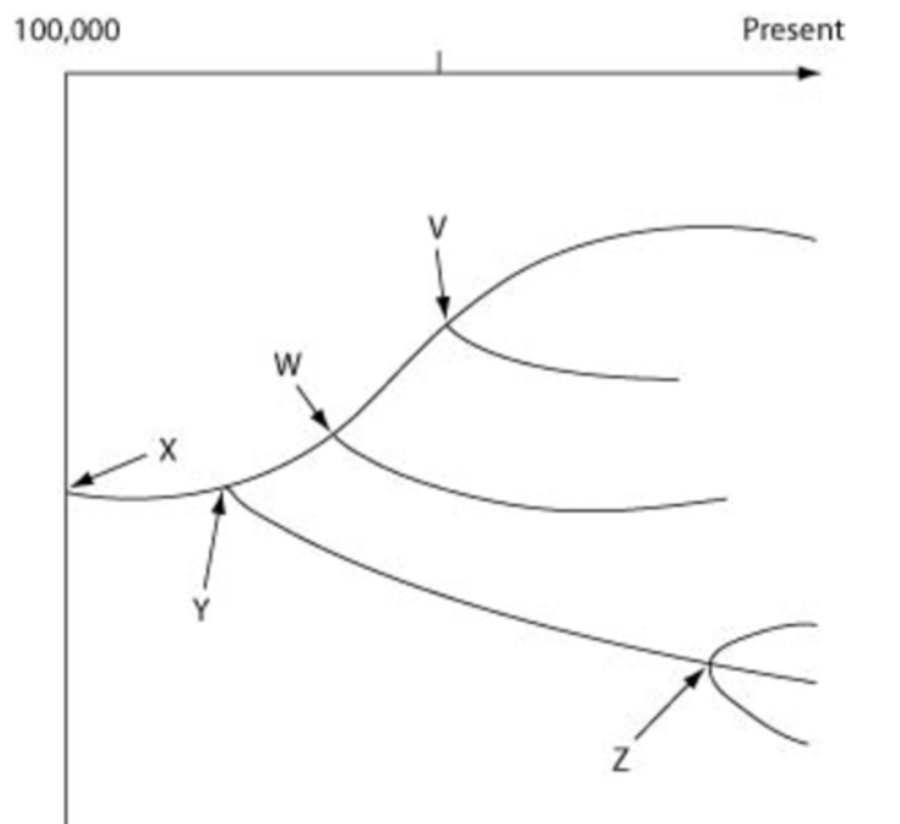
The horizontal axis of the cladogram depicted below is a timeline
that extends from 100,000 years ago to the present; the vertical axis
represents nothing in particular. The labeled branch points on the
tree (V—Z) represent various common ancestors. Let's say that only
since 50,000 years ago has there been enough variation between the
lineages depicted here to separate them into distinct species, and
only the tips of the lineages on this tree represent distinct species.
41) How many separate species, both extant and extinct,
are depicted in this tree?
6

The horizontal axis of the cladogram depicted below is a timeline
that extends from 100,000 years ago to the present; the vertical axis
represents nothing in particular. The labeled branch points on the
tree (V—Z) represent various common ancestors. Let's say that only
since 50,000 years ago has there been enough variation between the
lineages depicted here to separate them into distinct species, and
only the tips of the lineages on this tree represent distinct species.
42) According to this tree, what percent of the species
seem to be extant (in other words, not extinct)?
66%

The horizontal axis of the cladogram depicted below is a timeline
that extends from 100,000 years ago to the present; the vertical axis
represents nothing in particular. The labeled branch points on the
tree (V—Z) represent various common ancestors. Let's say that only
since 50,000 years ago has there been enough variation between the
lineages depicted here to separate them into distinct species, and
only the tips of the lineages on this tree represent distinct species.
43) Which of the five common ancestors, labeled V-Z, has
given rise to the greatest number of species, both extant and
extinct?Both X and Y can be considered to have given rise to the
greatest number of extant and extinct species
both x and y

The horizontal axis of the cladogram depicted below is a timeline
that extends from 100,000 years ago to the present; the vertical axis
represents nothing in particular. The labeled branch points on the
tree (V—Z) represent various common ancestors. Let's say that only
since 50,000 years ago has there been enough variation between the
lineages depicted here to separate them into distinct species, and
only the tips of the lineages on this tree represent distinct species.
44) Which of the five common ancestors, labeled V-Z, has
been least successful in terms of the percent of its derived species
that are extant?
W
the appearance of a fertile, polyploidy individual within a
population of diploid organisms is a possible source of a new species.
if this individual is capable of reproducing to form a new population.
scientists would consider this to be an example of:
A. allopatric
speciation
B. sympatric speciation
C. polygenic
speciation
D. genetic drift
E. hardy weinberg equilibrium
B
what is the only factor that can change allele frequencies in
populations to produce adaptive evolutionary change?
A.
mutation
B. gene flow (immigration)
C. non-random
mating
D. genetic drift
E. selection
E
The evolution of several species from a single species, each occupying a different niche
a. adaptive radiation
b. competitive exclusion
c. convergent evolution
d. founder effect
a
the establishment of a genetically unique population through genetic drift
a. adaptive radiation
b. competitive exclusion
c. convergent evolution
d. founder effect
D
the indepedendent development of similarities between unrelated groups resulting from adaptation to similar environments
a. adaptive radiation
b. competitive exclusion
c. convergent evolution
d. founder effect
C
genetic drift is increased by all of the following EXCEPT:
A.
small population size
B. bottleneck effects when the population
size is greatly reduced, then recovers
C. founder effects when a
small number of individuals are isolated and reproduce to form a new
sub-population
D. movement of individuals from one isolated
population to another
E. genetic isolation of a small groups
within a population
D
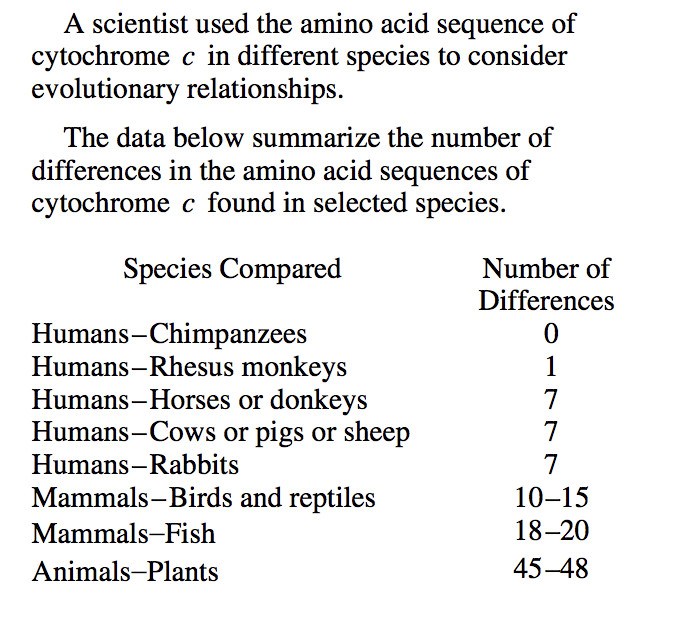
Interpretation of the data supports which of the following statements?
(A) Rhesus monkeys are more closely related to rabbits than they are to horses.
(B) Horses and cows have identical amino acid sequences in their cytochrome c.
(C) Humans are more closely related to rabbits than they are to rhesus monkeys.
(D) Plants and animals have no similarities at all.
(E) Mammals are more closely related to reptiles than they are to fish.
A
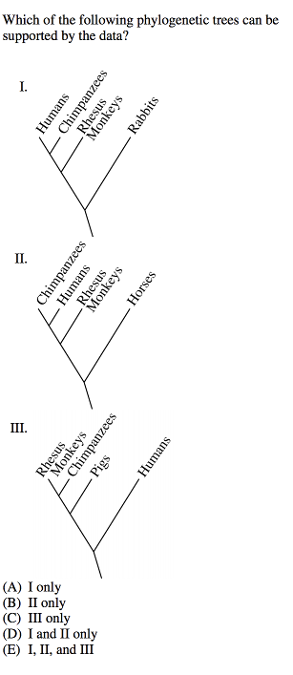
D
in a small group of people in kentucky, there is a high incidence of
"blue skin", a condition that results from a variation in
structure of the hemoglobin. all of the blue skinned residents can
trace their ancestry to one couple, who were among the original
settlers of this region. the unusually high frequency of blue skin is
an example of
A. mutation
B. genetic drift
C. natural
selection
D. sexual selection
E. heterozygote advantage
B
some varieties of the bacteria, neisseria gonorrhoeae, are now
resistant to penicillin, these varieties of bacteria most probably
developed as a result of...
A. selection
B. hybrid
vigor
C. coevolution
D. adaptive radiation
E.
convergent evolution
a
although the seal and the penguin both have streamlines, fish-like
bodies with a layer of insulating fat, they arent closely related.
this similarity results from
A. convergent evolution
B.
adaptive radiation
C. homologous evolution
D.
coevolution
E. analogous evolution
a
Rates of adaptive radiation typically are at their highest in which
of the following
situations?
-----------------------------------------------
[A]
When Earth is exposed to increased electromagnetic waves caused by Sun
flares.
[B] In very large, randomly mating
populations.
[C] When new niches become available
[D] When many species are competing for the same limited
resource.
[E] When food is abundant.
C
Which of the following best summarizes the theory of punctuated
equilibrium?
-----------------------------------------------
[A]
After periods of directional selection, the allelic frequencies in a
population will reach equilibrium and then undergo disruptive
selection.
[B] Most species evolve gradually, with
discrete changes appearing in the fossil record at short, regular
intervals.
[C] Once one species achieves evolutionary
dominance, all of the remaining species must compete among themselves
for selective advantages; only then will the dominant species be
challenged.
[D] To ensure survival of the fittest,
natural selection eliminates those species that disrupt the balance
of nature.
[E] Most taxa experience relatively short
periods during which they undergo rapid change, followed by
relatively long periods during which they undergo relatively little change.
E
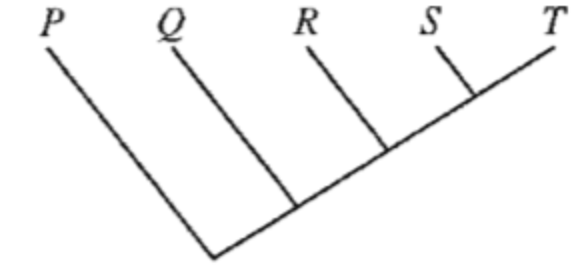
Which of the following conclusions is best supported by the cladogram
above?
-----------------------------------------------
[A]
Species Q and R make up a monophyletic group.
[B] Species
P and Q are equally related to species T.
[C] Species P
and T do not share a common ancestor.
[D] Species S
evolved from species R.
[E] Species S is more closely
related to species T than to species R.
E
A large assemblage of land snails is subdivided into two populations
(A and B) by a river that effectively isolates the two populations for
an indefinitely long period. From an evolutionary standpoint, which of
the following is the LEAST likely to occur in the two
populations?
-----------------------------------------------
[A]
Populations A and B will eventually differ in their ecological
requirements.
[B] Population A may ultimately breed at a
different time of the year than population B does.
[C]
Population A may undergo instantaneous speciation by the doubling of
its chromosome numbers (polyploidy).
[D] Under laboratory
conditions, cross fertilizations between members of the two
populations may be successful even after a long period of
geographical separation.
[E] The two populations may
become morphologically very dissimilar.
C
What components of the gases found in the early atmosphere were beneficially in providing the building blocks for life
a. N2 gas and ammonia
b. methane and carbon dioxide
c. carbon dioxide and water vapor
d. sulfur dioxide and oxygen
a
Which of the following pairs of plants are most closely related?
1. Broad bean (Vicia faba)
2. Soybean (Glycine max)
3. Kidney Bean (Phaseolus vulgaris)
4. Barley (Hordeum
vulgaris)
5. Scarlet runner bean (Phaseolus coccinus)
A) 1 and 2
B) 1 and 3
C) 2 and 3
D) 3 and 4
E) 3 and 5
E
Which of the following is the correct sequence of these events in the
origin of life?
I. formation of protobionts
II. synthesis of
organic monomers
III. synthesis of organic polymers
IV.
formation of DNA-based genetic systems
A) I, II, III, IV
B) I, III, II, IV
C) II, III, I, IV
D) IV, III, I,
II
E) III, II, I, IV
C
The first genes on Earth were probably
A) DNA produced by
reverse transcriptase from abiotically produced RNA.
B) DNA
molecules whose information was transcribed to RNA and later
translated in polypeptides.
C) auto-catalytic RNA molecules.
D) RNA produced by autocatalytic, proteinaceous enzymes.
E) oligopeptides located within protobionts.
C
If natural selection in a particular environment favored genetic
systems that permitted the production of daughter "cells"
that were genetically dissimilar from the mother "cells,"
then one should expect selection for
I. polynucleotide polymerase
with low mismatch error rates.
II. polynucleotide polymerases
without proofreading capability.
III. batteries of efficient
polynucleotide repair enzymes.
IV. polynucleotide polymerases
with proofreading capability.
V. polynucleotide polymerases with
high mismatch error rates.
A) I only
B) I and IV
C)
I, III, and IV
D) II and V
E) II, III and V
D
What is true of the fossil record of mammalian origins?
A) It
is a good example of punctuated equilibrium.
B) It shows that
mammals and birds evolved from the same kind of dinosaur.
C) It
includes transitional forms with progressively specialized teeth.
D) It indicates that mammals and dinosaurs did not overlap in
geologic time.
E) It includes a series that shows the gradual
change of scales into fur.
C
An early consequence of the release of oxygen gas by plant and
bacterial photosynthesis was to
A) make life on land difficult
for aerobic organisms.
B) change the atmosphere from oxidizing
to reducing.
C) make it easier to maintain reduced molecules.
D) cause iron in ocean water and terrestrial rocks to rust
(oxidize).
E) prevent the formation of an ozone layer.
D
Recent evidence indicates that the first major diversification of
multicellular eukaryotes may have coincided in time with the
A)
origin of prokaryotes.
B) switch to an oxidizing atmosphere.
C) melting that ended the "snowball Earth" period.
D) origin of multicellular organisms.
E) massive eruptions
of deep-sea vents.
C
Which event is nearest in time to the end of the period known as
snowball Earth?
A) oxygenation of Earth's seas and atmosphere
B) evolution of mitochondria
C) Cambrian explosion
D) evolution of true multicellularity
E) Permian extinction
C
There are at least a dozen known species in the extinct genus
Lystrosaurus. If each species was suited to a quite different
environment, then this relatively large number of species is likely
due to
A) sexual selection.
B) adaptive radiation.
C) heterochrony.
D) polyploidy.
E) species selection.
B
If these fly species lost the ability to fly independently of each
other as a result of separate mutation events in each lineage, then
the flightless condition in these species could be an example of
A) adaptive radiation.
B) species selection.
C)
sexual selection.
D) allometric growth.
E) habitat differentiation.
B
Which example below will most likely guarantee that two closely
related species will persist only as distinct
biological
species?
A) colonization of new habitats
B) convergent
evolution
C) hybridization
D) geographic isolation from one
another
E) reproductive isolation from one another
e
Which of these should decline in hybrid zones where reinforcement is
occurring?
A) gene flow between distinct gene pools
B)
speciation
C) the genetic distinctness of two gene pools
D)
mutation rate
E) hybrid sterility
a
According to the concept of punctuated equilibrium, the ʺsuddenʺ
appearance of a new species in the fossil
record means
that
A) the species is now extinct.
B) speciation occurred
instantaneously.
C) speciation occurred in one
generation.
D) speciation occurred rapidly in geologic
time.
E) the species will consequently have a relatively short
existence, compared with other species.
d
According to the concept of punctuated equilibrium,
A) natural
selection is unimportant as a mechanism of evolution.
B) given
enough time, most existing species will branch gradually into new
species.
C) a new species accumulates most of its unique features
as it comes into existence.
D) evolution of new species features
long periods during which changes are occurring, interspersed
with
short periods of equilibrium, or stasis.
E)
transitional fossils, intermediate between newer species and their
parent species, should be abundant.
c